…Morpheus, a master craftsman and simulator of human forms.
No one else is as clever at expressing the movement,
the features, and the sound of speech.
Ovid 1
All poetic art and poeticising
Is nothing but interpreting true dreams.
Hans Sachs 2
The German Origin
In his Three Books Of Occult Philosophy (1533), German polymath Heinrich Cornelius Agrippa defines magic as “the most perfect and chief science, that sacred, and sublime kind of philosophy [….] For seeing that all regulative philosophy is divided into natural, mathematical, and theological.”3 Knowledge canon surrounding Northern Renaissance was founded by a tensional juxtaposition between the surviving medieval esotericism and the upcoming humanism and naturalism channeled by Italian Renaissance. Furthermore, no other cultural scenario in Western history produced an iconography of alchemy as abundant as Northern Renaissance. The alchemist, in his crossroad between nature and metaphysics, will be represented surrounded by equal amounts of books and instruments for chemistry practice.4 The alchemist personifies a more extended aim to disclose transcendental mysteries by means of science.
It should not surprise that after such an influential backdrop, modern notion of ‘magic realism’ for literature and art would originate within a Germanic scholarly tradition, where an articulation between the uncanny and the empirical world has prevailed. In 1925, German art critic Franz Roh coined the term magischer realismus in his book After Expressionism: Magical Realism: Problems of the Newest European Painting. Roh’s notion of magic realism was associated with the return to realism by post-expressionist German painters such as George Grosz, Otto Dix, Christian Schad and Max Beckmann.5 The purpose was to address the spirit of the “objective world” in an epoch marked by the aftermath of the industrial revolution.6 Roh wrote: “with the word ‘magic’ as opposed to ‘mystic,’ I wished to indicate that the mystery does not descend to the represented world, but rather hides and palpitates behind it.”7 This kind of “animism” of the modern world opened a new aesthetic territory founded in the apparent antithetical pair of the “magical” and the “real”, within the understanding of art as the construction of alternative realities.
A representative case for Roh’s notion of magic realism is a series of artworks George Grosz made in 1920 in which the main characters – depicted as a sort of cyborgs or mannequins – inhabit silent, geometrically sketched cityscapes. The mixed-media piece Daum marries her pedantic automaton George in May 1920, John Heartfield is very glad of it shows extreme contrast of attitudes between the two characters, highlighted by styles and techniques.8 Grosz’s wife Eva Peter (nicknamed by her husband as Maud, the anagram of “Daum”) is portrayed in a sensual attire and pose, with softened forms expressed in dynamic ink and watercolour. Conversely, Grosz depicts himself as a cold and mechanical figure made up of a puzzle of collaged magazine paper cuts with references to early 20th century industrial world. Daum and George are sited in a hollow, sterile, Giorgio-de-Chirico-fashioned metaphysical urban environment.
It is precisely Grosz’s metaphysical enquiry on reality based on ideal-analytical models what makes this series an illustration of Roh’s interest about the eerie or magic essence concealed under the facade of a mathematically objective realism. Such objectivist aesthetics made Grosz part of society’s obsession with machinery that characterised the German branch of Dadaist movement he has been associated with, in the period between the world wars. The apparent incommensurability of the paradigmatic dualism portrayed at the marriage between the sensual and vitalist Daum and the rational and mechanist George points to two opposite forms of excess in 1920s German society: sexual decadence (a leitmotif in Grosz’s art) and techno-militarism.
The ‘automaton’ George repeats the visual pattern of other German Dadaist icons such as Raoul Hausmann’s (in the same year, 1920) equally impassive assemblage entitled This triMechanical Head (Spirit of Our Age).9 Both characters bear instruments related to precision and quantification. Noticeably, they both wear ‘rulers’ glued to their foreheads. Such ‘rulers’ suggest the measurable quality of the intellectual or operational capacity of those mechanical totems. Today, in the same fashion, the capacities (HD data, RAM, and weight) becomes the forerunning value of electronic media. In contrast to such mathematical equations of ratio, the all-too-human Daum, misplaced in such a clinical space, recalls Francis Bacon’s poignant figures melting down in the midst of solid, neutral and aseptic confinements.
Daum and George wed the two opposite and complementary forms of alienation of interwar Germany: apocalypse and integration (recalling Umberto Eco); hedonism and pragmatism; hyper-sensuality and hyper-rationality. They also emblematise the two sides of a predicament addressed by German philosophy since Immanuel Kant’s Critique of Judgment (1790): the (dis)articulation between art and reality. Discussing the nature of “disinterest” of the aesthetic judgment regarding the reference (reality), Kant said:
Now, where the question is whether something is beautiful, we do not want to know, whether we, or any one else, are, or even could be, concerned in the real existence of the thing, but rather what estimate we form of it on mere contemplation (intuition or reflection). [….] One must not be in the least prepossessed in favour of the real existence of the thing, but must preserve complete indifference in this respect, in order to play the part of judge in matters of taste.10
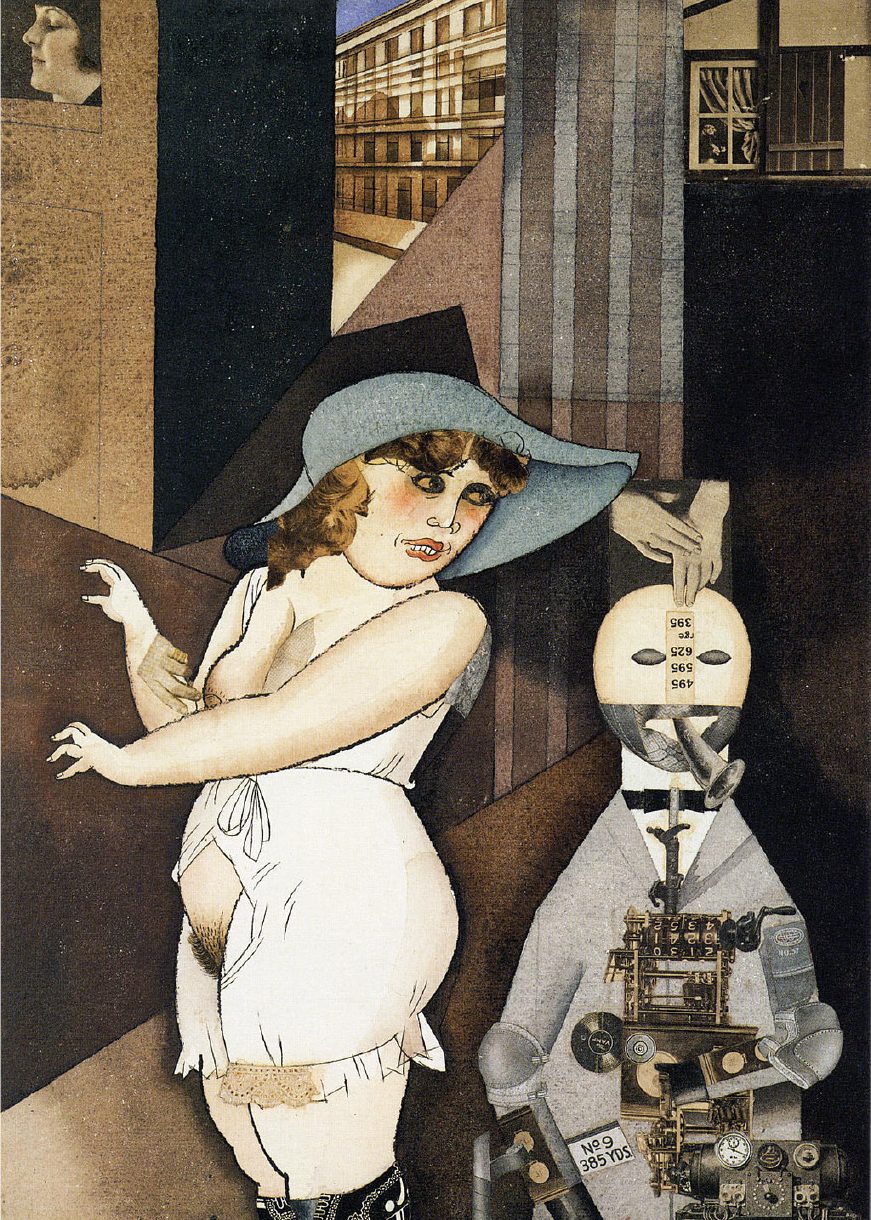
George Grosz
Daum marries her pedantic automaton George in May 1920, John Heartfield is very glad of it,
Watercolours over drawing pen, collage on card, 1920, Berlinische Galerie, Berlin
Kant contentiously announces that the aesthetical experience can only be fulfilled by renouncing reality as a reference for artistic measurement. Since then, the horizon between the “real existence of the thing” and the reflective realm of “mere contemplation” would become a conceptual battleground in view of modern and contemporary art.
These two dimensions would be subsequently addressed in Friedrich Nietzsche’s first book The Birth of Tragedy (1872) and in Martin Heidegger’s essay, The Origin of the Work of Art, drafted during the 1930s. Nietzsche would perceive the contemplative experience as a sort of dream allegorised by Apollo. He wrote:
In the same manner the Greeks expressed this joyful necessity of the dream experience in their Apollo. Apollo, as the god of all the plastic arts [….] he also rules over the beautiful appearance of the inner fantasy world. [….] But also that delicate line which the dream image may not cross so that it does not work its effect pathologically— otherwise the illusion would deceive us as crude reality—that line must not be absent from the image of Apollo, that boundary of moderation, that freedom from more ecstatic excitement, that fully wise calm of the god of images.11
The Dionysian world as such was the ‘pathology’ against which the German philosopher considers the boundary of the Apollonian “dream image.” Nietzsche related the artistic compulsion, or kunsttrieben, in the encounter between Apollo and Dionysus: brothers in arm-wrestling, light and wine, reason and ecstasy, poetics and “earthly delights.” Nietzschean aesthetics would become a currency in the 20th century’s intensive struggle with the (im)possibility of art to build a universe on its own.
Apollonian George and Dionysian Daum would continue their tensional and dialogical relationship as a form of heaven and earth. Heidegger argued that the work of art “sets up a world” and yet, it cannot mask its earthen materiality.12 Apollo (or George) aims to settle his own reality, his spiritual kingdom. And yet, he cannot do without the “down-to-earth” substance offered by Dionysus (or Daum). The work of art is spirit as it is also clay. It points upward and downward. It is ethereal and telluric. The work of art becomes a self-driven third dimension between heaven and earth.
Latin American and the Marvel Underground
Today, magic realism is no longer associated with Roh’s view nor with post-World War One German artistic apogee. The idea of a rational world that performs as imitation of dreams, a naturalisation of fantasy in the ordinary reality, found an especially fecund terrain in 20th century Latin American literature and art, due to certain historical and cultural conditions.
In the prologue to his novel The Kingdom of this World (1949), Cuban writer Alejo Carpentier elaborated on these conditions under his concomitant notion of “the marvelous real.” Basically, this notion consists of the localisation of magic realism in the historical circumstances of ethnical, cultural and mystical hybridity of America, which he considers “a chronicle of the marvellous in the real.”13 Some scholars like Maggie Ann Bowers consider both, this notion and this novel, as the origin of Latin American realismo mágico.14
The novel is a portrait of the social imaginary and popular beliefs surrounding the Haitian Revolution and its historical/mythical leader Henri Christophe, who was born slave and died as Henry I, King of Haïti. The title of The Kingdom of this World refers to the marvels of the earth by contrast with those assigned to the Kingdom of Heaven. It could be also interpreted with reference to the magical reality of a European-style African descendent monarchy in the New World, which in few years built dozens of palaces, châteaux and fortresses. That included the magnificent Palace of Sans-Souci, regarded as the Caribbean Versailles and the crown jewel of Haitian nobility.
Writers such as the Argentinian Jorge Luis Borges, the Guatemalan Miguel Ángel Asturias, the Colombian Gabriel García Marquez and the Chilean-American Isabel Allende would be identified with the notion of magic realism; along with a number of visual artists, mostly settled in Mexico, such as the Spanish Remedios Varos, the English Leonora Carrington and the Mexican Frida Kahlo.
These visual artists have been generally misplaced in the backseats of European surrealism. In his 1938 trip to Mexico, when André Breton enthusiastically declared this nation to be “the surrealist place par excellence” he was decontextualising Mexican ethnographic and cultural repertoire, as much as Picasso had previously done with African masks in the faces of Les Demoiselles d’Avignon.15 Latin American magic realism would have little of psychic automatism, in a context in which an umbrella and a sewing-machine may have plenty of reasons to settle a meeting on a dissecting-table.16 An oneiric reality in Latin American cultural history would be less associated with a Freudian informed idea of the unconscious, and more with a socio-historical context in which rationalism ‘shipped’ from European enlightenment have been syncretised with and corrupted by local (para)rational “flavours.”
Carpentier visited Haiti in 1943 and Breton went right after in 1944-45. Yet, they interpreted Haitian cultural and spiritual intricacies in very dissimilar ways. It was so, even though both were attentive to the same historical ingredients and influences, such as the ideology of the French Revolution mixed with domestically grown anti-slavery and anti-colonialism, French enlightenment blended with the “endarkenment” of voodoo, and the above-mentioned black aristocracy.
Carpentier’s defined “the marvelous real” in opposition to what he would perceive as two extreme positions: surrealism and the “return to the real.” As a part of the existing “codes of the fantastic,” Carpentier called surrealist practice a “timeworn formulae” of “cheap magic” “born of disbelief” by which “determined to invoke the marvelous at any cost, the miracle workers turn into bureaucrats.”17 For Carpentier, the difference between “the surreal” and “the marvelous real” is how fantasy roots in an intellectual operation or in a cultural history, respectively. He believes that the “true marvelous”:
…arises from an unexpected alteration of reality (a miracle), a privileged revelation of reality, an unaccustomed or singularly favourable illumination of the previously unremarked riches of reality, an amplification of the measures and categories of reality, perceived with peculiar intensity due to an exaltation of the spirit which elevates it to a kind of “limit state.”18
Against the idea of surrealism as a form of methodological madness, Carpentier claims that the flow of marvels of The Kingdom of this World developed from “the most rigorous documentation, [….]which conceals, beneath its apparent intemporality, a meticulous collation of dates and chronologies.”19
In the case of the visual arts, the paradoxical possibility of a “rational interpretation of the irrational” for most of what have been labelled under “Latin American surrealism” appears remarkably obvious. Tracing the visual narrative of artists such as Remedios Varo, one realises that her dreamlike ambiances convey fully readable inner logics, leaving no room for the deliberate senselessness of surrealism. After her active involvement with the surrealist circle in Paris, Varo left for Mexico in 1941 and there, her art, evolved into a personal cosmogony. Her paintings appear to unfold as a series of analytical chapters that Mexican writer Octavio Paz called “machinery of fantasy.”20
A close observation of her painting Harmony (1956), for instance, may produce a hermeneutic situation not so dissimilar from the one demanded by a heavily symbolic artistic forms of the Northern Renaissance. This painting shows one of her typical modern gothic interiors in which an androgynous character is occupied in trying to communicate with an other worldly dimension.21 Mexican art historian Luis-Martin Lozano interprets this painting as follows:
Armonía (Harmony) was conceived as a suggestive self-portrait in which Varo assumes the function of keeper of the universe. She communicates with the beyond by means of a musical stuff. With magic crystals and quartz stones, Varo rediscovers – like a Helmes Trismegisto, keeper of universal wisdom – consonance in a dual world.22
In this case, a composer creates a piece of music by stringing real objects together, using the lines of a three-dimensional treble clef musical staff . The objects fall into three categories: vegetation (flowers, leaves, crops…); paper scraps with mathematic notations; and three-dimensional geometric shapes. Music is made out of harmonising nature and science, the empirical and the metaphysical. The lines of the musical staff become the subtle connecting strings, the living vessels between the two dimensions.
Harmony may recall what has been considered the most studied print in Western Art History: the equally symbolically overcharged Albrecht Dürer’s Melencolia I (1514). This print features a winged figure who, absorbed in contemplation, appears to be detachedly using a compass.23 As much as in Varo’s painting, geometry is a prominent feature in Dürer’s engraving. Two geometrical solids, a polyhedron and a sphere, occupy prominent locations within the composition, complemented by instruments of measurement such as a magic square, a scale and a sand clock. The composer and the “melancholic angel” ‘systematise’ beauty by geometrical knowledge.
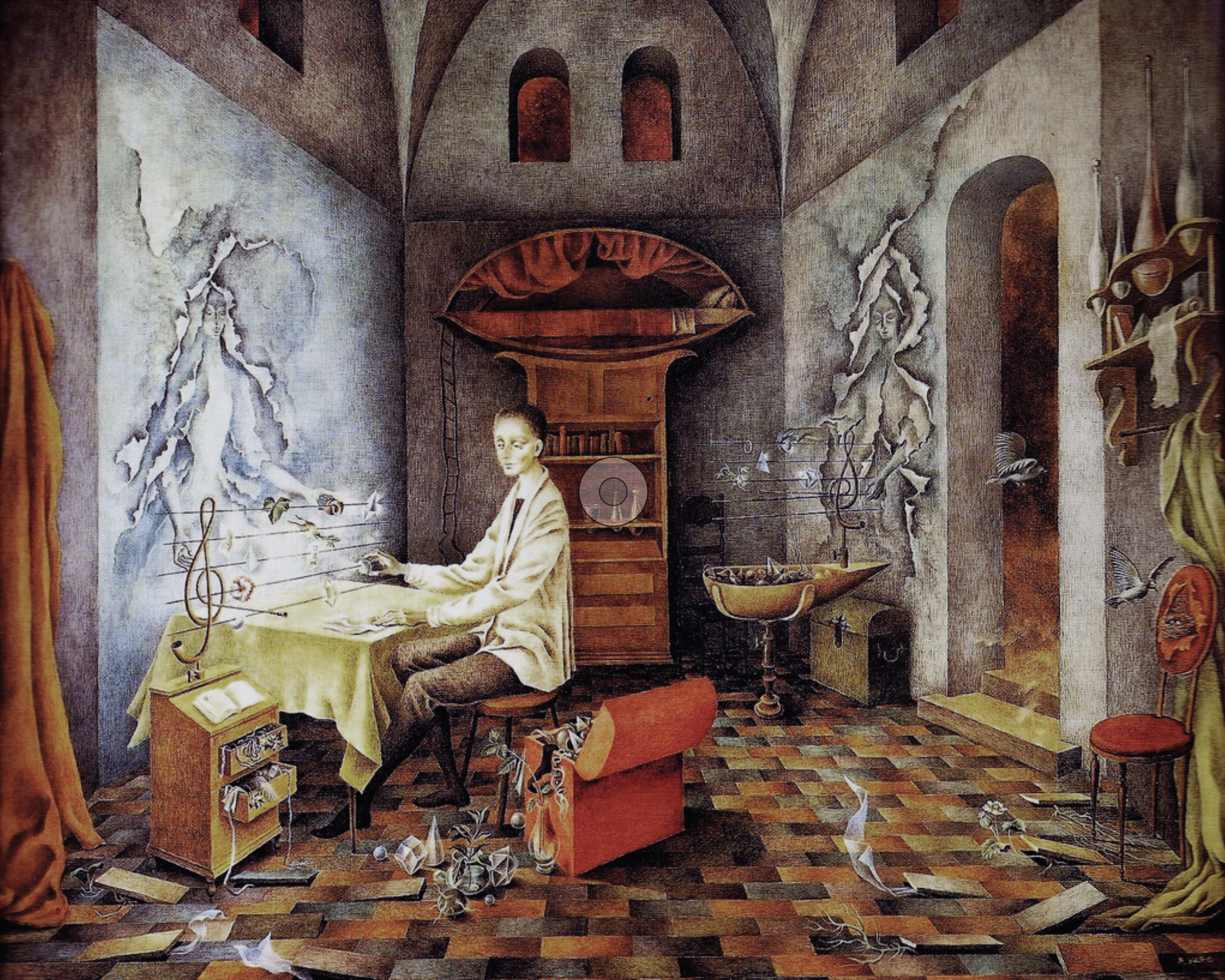
Remedios Varo
Harmony, 1956, Oil on masonite, Private collection
Agrippa begins his Three Books Of Occult Philosophy explaining that the world is made up of a threefold alchemical enquiry: the ‘elementary’, the ‘celestial’ and the ‘intellectual.’24 Harmony and Melencolia implicates the same three dimensions in the empirical, the spiritual and the rational. In Harmony, a shelf containing books and items related to chemical experiments dominates the background.25 Some scholars believe that the title Melencolia I may refer to the first of the three types of melancholy defined by Agrippa that Dürer had access to. The “I” must stand for ‘imagination,’ the melancholic positioning of the artist. This is in contrast to ‘reason’ and ‘spirit,’ the sentiments of the intellectual and theologian, respectively.26
Dürer’s print embodies the singular moment in European cultural history, framed by such a triangular relationship of these ideas. The artist’s status was under negotiation between the tradition of craftsmanship and the increasing intellectual demands. Instruments of abstract thinking along with instruments of carpentry surround the angel of melancholy. She bears wings and yet she is grounded by her own weight. She may be able to contemplate the celestial occurrences – the comet and the rainbow – but she remains shackled by her physical imminence.
Melencolia I and Harmony reveal a continuum – from the beginning until the present of Modern era – regarding the anxiety about the cryptic universal principles that determine human condition. Both images appeal to a secret geometry as its Rosetta Stone, to decipher those principles. Melencolia I‘s polyhedron and Harmony’s quartz stones resemble the Platonic solid models for the understanding of the Solar system that again, German Renaissance astronomer Johannes Kepler had detailed in his groundbreaking book Mysterium Cosmographicum.
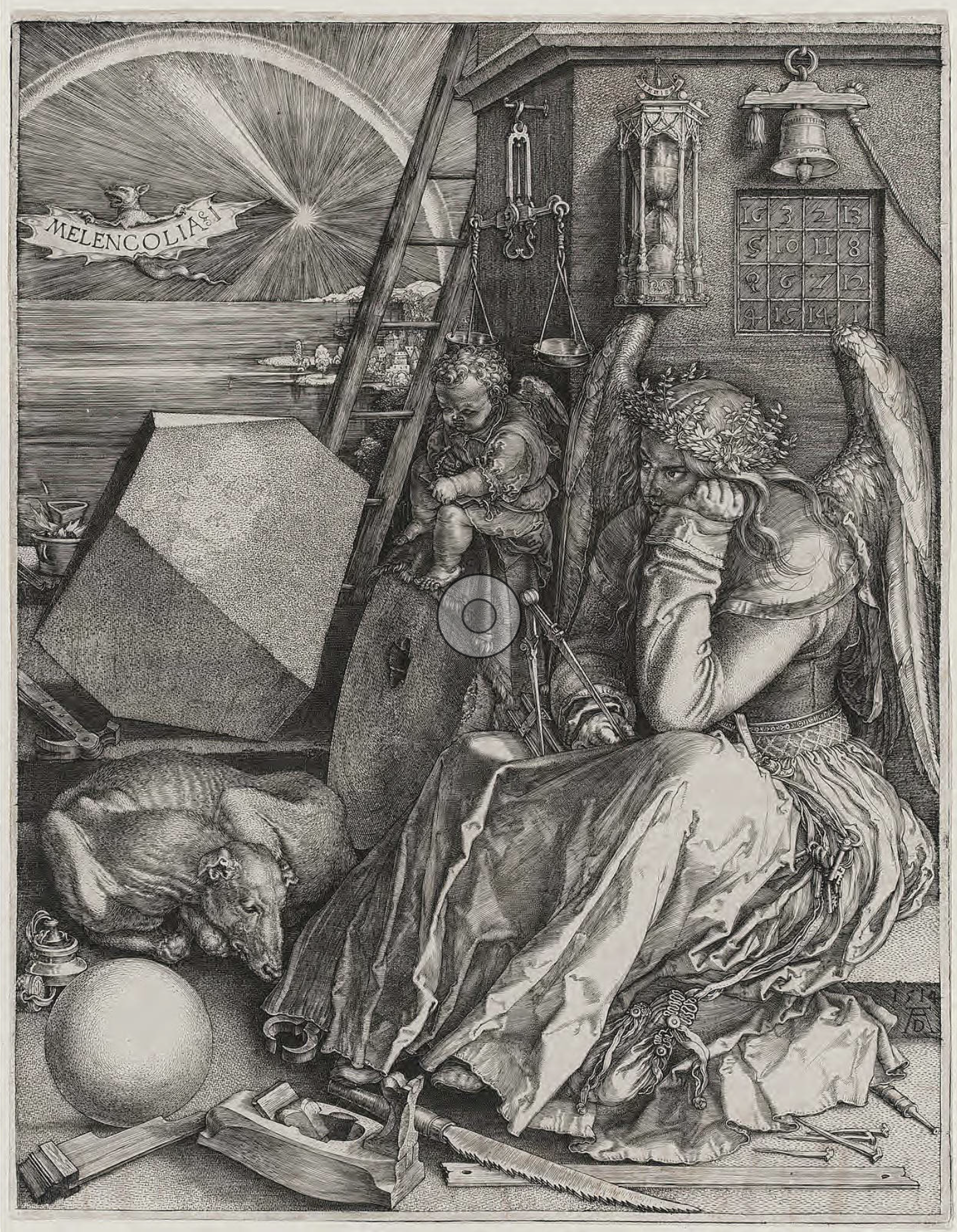
Albrecht Dürer Melencolia I, 1514, Engraving
The Prospect of New Media
Remedios Varo’s characters isolated in their spectral architecture would find their rabbit hole in digital technology.27 The prospect of a fully implemented computer generated reality, a manmade world will mean the dissolution of the tension between the magical and the real, within the suspension of boundaries between life and art understood as illusion, mirroring, representation. If the history of magic realism is the saga of literature and art’s imitation of the marvel, and illogicality of reality; the history of virtual reality will be simply the tale of reality imitating art by means of technology. Virtual reality is in the first place, the capacity to trespass a work of art, to live in the illusory side of the screen, on the wrong side of the mirror.
One of the critical objectives of literature associated with magic realism was precisely to create areas of uncertainty by overlapping the world of literary fiction and the world of the author and/or the reader. This resource was mastered by Borges and his exploration on the chronotopic (dis)continuities and bifurcations between fiction and reality. Such exploration anticipated new media concepts such as hypertext, telepresence and interface.
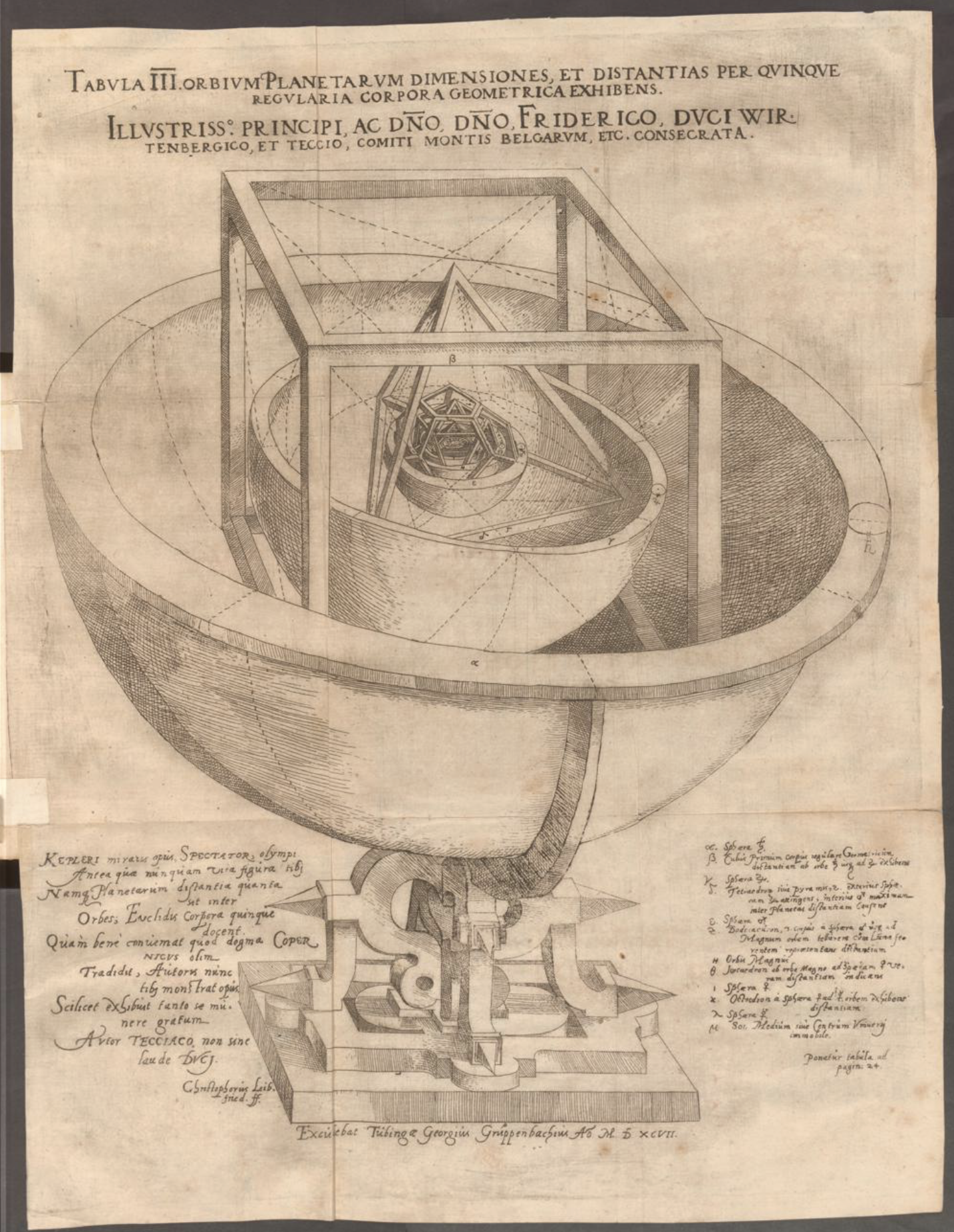
Johannes Kepler’s Platonic solid model of the Solar system.
From original 1596 edition, in Latin, of Mysterium Cosmographicum.
It is not a coincidence that two of the books that better served as philosophical bedrocks for new media age begin by referring to Borges’ stories: Foucault’s The Order of Things: An Archaeology of the Human Sciences (1966) and Jean Baudrillard’s Simulacra and Simulation (1981).
Foucault’s epistemological treaty discusses what different moments in cultural history accept as the “truth of science.” The preface acknowledges that the book was inspired by a passage from Borges’ short essay, The Analytical Language of John Wilkins, published in 1952. The passage is a hilarious apocryphal taxonomy built by a Chinese encyclopaedia entitled Celestial Empire of Benevolent Knowledge. Such document would classify animals as: “(a) belonging to the emperor; (b) embalmed; (c) tame; (d) sucking pigs; (e) sirens; (f) fabulous; (g) stray dogs; (h) included in the present classification; (i) frenzied; (j) innumerable; (k) drawn with a very fine camelhair brush; (l) et cetera; (m) having just broken the water pitcher; (n) that from a long way off look like flies.”28
Such an intention to confer scientific systematisation to fantasy may bring to mind some of the chronicles published after the accounts provided by the first European explorers of America. The ground-breaking Atlas of the New World (Nova Typis Transacta Navigatio Novi Orbis Indiae Occidentalis, 1621) was authored by the Austrian Benedictine abbot Caspar Plautius (under the pseudonym of Honorius Philoponus), and illustrated by the German printmaker Wolfgang Kilian. Kilian’s highly detailed plates would dedicate one page to an accurate depiction of American agriculture, and the next to the fantastic portrayal of the 5th century Irish monk Saint Brendan celebrating mass on the back of a whale on his westward voyage through the Atlantic Ocean searching for the Garden of Eden (Plate 2).
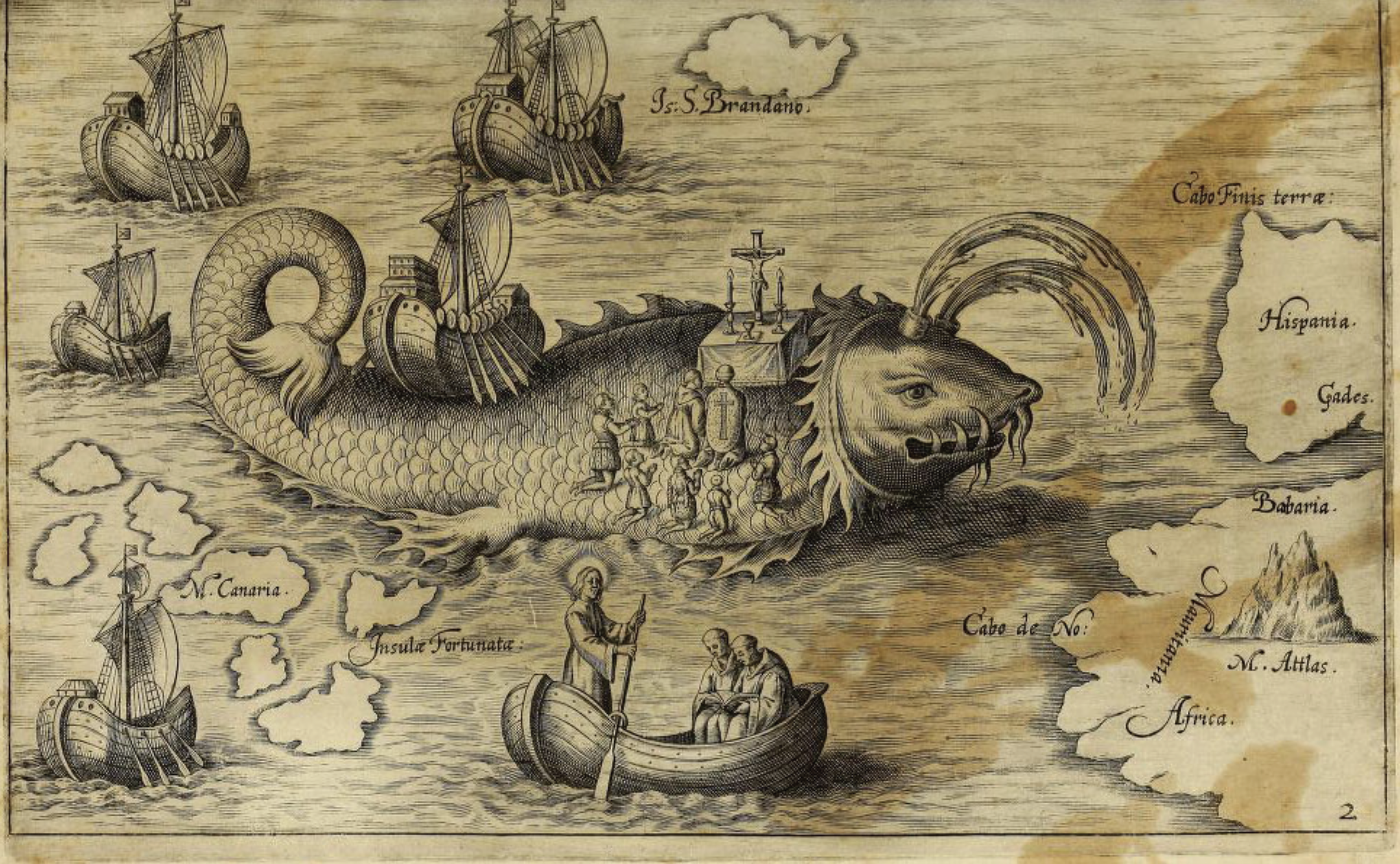
Wolfgang Kilian (attributed)
“Plate 2”, Caspar Plautius. Nova Typis Transacta Navigatio Novi Orbis Indiae
Occidentalis,1621
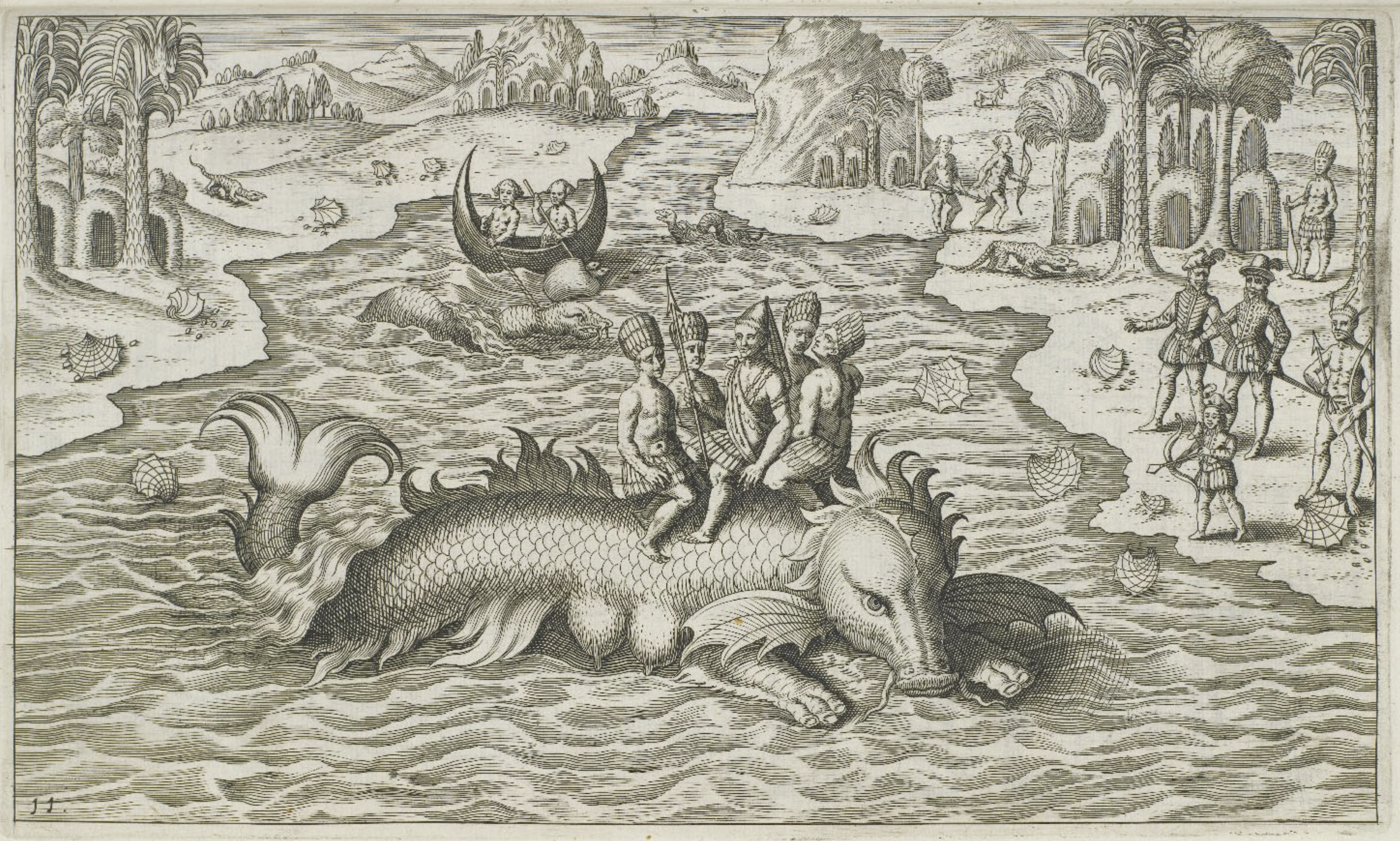
Wolfgang Kilian (attributed)
“Plate 11”, Caspar Plautius. Nova Typis Transacta Navigatio Novi Orbis Indiae
Occidentalis, 1621
Kilian’s Plate 11 describes two Europeans encountering the New World where aboriginal people share their environment with fanciful animals. At the foreground, a number of West Indians sail on the back of a sea monster bearing female breasts and a dragonhead. The image appears extremely similar to the Boschian fantasies that characterised Northern Renaissance. The combination of the naturalistic métier of the Italian Renaissance and the medieval hallucinatory subject-matters intend to confer an aura of authenticity. Such a sense of truthfulness is not dissimilar to Borges’ zoological categorisation in which sirens appear next to sucking pigs.29
Intended as a scientific and historic record, Plautius’ Atlas is perhaps the first piece of magic realism to be inspired by America’s marvels. In the 1960s, during the early stage of decolonisation and still under the influence of a rather monochord Western epistemology, Foucault believed that “the exotic charm of another system of thought” demonstrates “the limitation of our own.”30 Today’s multiplicity of epistemological paradigms arose under different set of conditions, in particular on two fronts: decolonisation and the age of information and communication. In such an environment, there are no longer domestic and exotic systems of thought. Forms of fantastic narrative pretended as empirical observation and scientific scholarship, such as Plautius’, reveal not only the idiosyncratic but even aesthetical nature of knowledge. Borges’ list could only advance the “(dis)order of things” triggered by TV channel zapping, digital networking and other resources for new media epistemological rapture.
In Baudrillard’s thesis on simulacrum, Borges’ one-paragraph story On Rigor in Science, published in 1946, is recalled. As with the Chinese encyclopaedia mentioned earlier, this short story appears to be another literary forgery. It is about an empire obsessed with cartography, so that “the Cartographers Guilds struck a Map of the Empire whose size was that of the Empire, and which coincided point for point with it.”31 As further generations began to live on top of the scattered ruins of the map, there was not much difference between the map and the territory, between reality and “the metaphysical beauty of this ruined abstraction.”32
The parable of a map so precise that it ended up covering the entire territory, helped Baudrillard illustrate his notion of simulacrum as the capacity to live inside a constructed model that neglects reality. For the French philosopher, today’s hyper-reality is the situation of living in a map (an abstraction, a concept, a reference) without a preceding territory, “a referential being, or a substance.”33 Baudrillard’s considerations that lead to his apocalyptic dictum “the desert of the real” is the forecast of a world in which “today it is the territory whose shreds slowly rot across the extent of the map. It is the real, and not the map, whose vestiges persist here and there…”34
When the Wachowski brothers built a film around Baudrillard’s notion of simulacrum, they named the “gatekeeper” between The Matrix (a computer-generated world) and the physical reality after the ancient Greek god of dreams. Morpheus, now in the reversal role of emancipator from the world of illusions, asks the hero: “Have you ever had a dream, Neo, that you were so sure was real? What if you were unable to wake from that dream? How would you know the difference, between the dream world and the real world?”35 This is the moment in which a team of hackers is intending to track the flesh and blood Neo from his digital avatar. The (dis)connection between the real and the virtual is allegorised by a distorted mirror. Neo touches the mirror but instead of trespassing from one dimension to the other – between reality and reflexion – it is the mirror that trespasses Neo’s body.
Borges’ poem Mirrors expresses the same anxiety about living under the tyranny of mirrors: about just reflections, someone else’s dream, God’s puppetry, prisoners in Plato’s cave. The poem begins as:
I, who felt the horrors of mirrors
Not only in front of the impenetrable crystal
Where there ends and begins, uninhabitable,
An impossible space of reflections.36
As I write this, on the day that marks the 30th year of Borges’ passing, the advent of the digitally immersive art makes his poem all too vivid. Borges imagined the articulation between the writer and the literary character as similar to the God-man relationship. The poem ends as follows:
God has created night time, which he arms
With dreams, and mirrors, to make clear
To man he is a reflection and a mere
Vanity. Therefore these alarms.37
In the Matrix, Deus ex machine controls men by means of a fully implemented and everlasting aesthetical experience, a grand fiction, a digitally-enhanced version of Richard Wagner’s gesamtkunstwerk (total artwork). Foucault’s and Baudrillard’s references to different systems of “fantastic sciences” predefines contemporary culture as a form of techno-schizophrenia. An overtly scientific world of fantasy makes Franz Roh’s modest enquiry on magic realism a prediction of a Borgesian nightmare. It is the nightmare of a virtual reality with no exit door, of not been able to return from the work of art, to wake up from magic. It is the nightmare of becoming just another allegory for a reality that turns unreachable after the triumph of the cyber-alchemist.
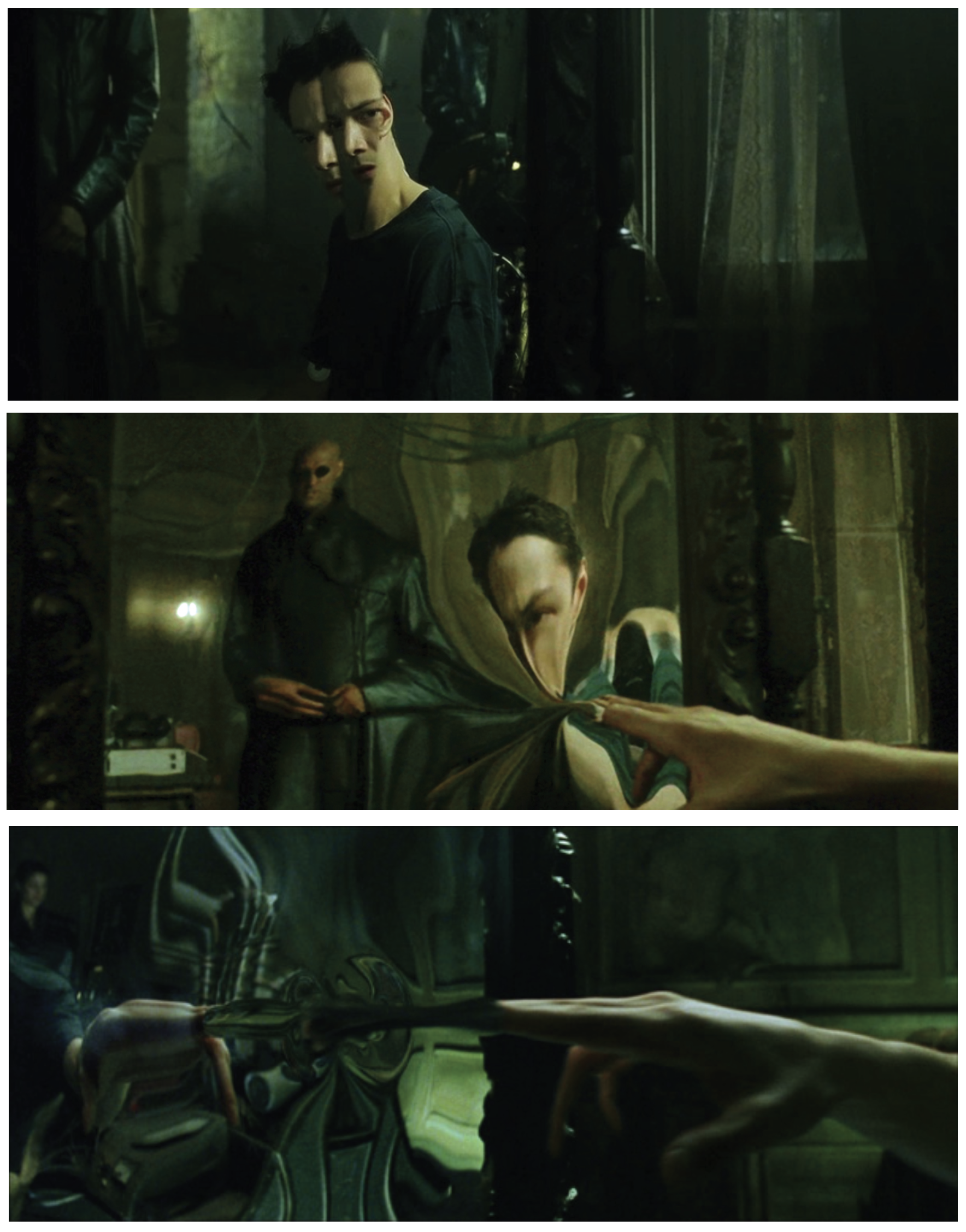
Stills from film The Matrix, 1999, Dir: Andy & Larry Wachowski.
Warner Bros Productions, USA


